When we transferred by bus from Pampulha to the centre of Belo Horizonte, it was quite late in the afternoon, while we were still keen on further sightseeing. Luckily, there are two museums at the main city square, Praça da Liberdade. Both are interesting in their own right and visiting them may take more time or you can creatively go through them quickly, as the two of us did on this occasion. We simply did not have enough time.
First we went to the Museum of Mines and Metals. Taking into consideration that the federal state of Minas Gerais has so much mineral wealth, it is quite normal that the capital of the state has a museum dedicated to this. In addition to the interesting architectural combination of an old building and new construction elements in the back part of the building, and a number of modern interactive displays, the museum also exhibits a very big and impressive collection of minerals, or crystals, if you prefer. In addition, Sneža and I found it interesting that most of the visitors were children. It is nice that they can see what it is that exists in their country and, hopefully, learn something about it.
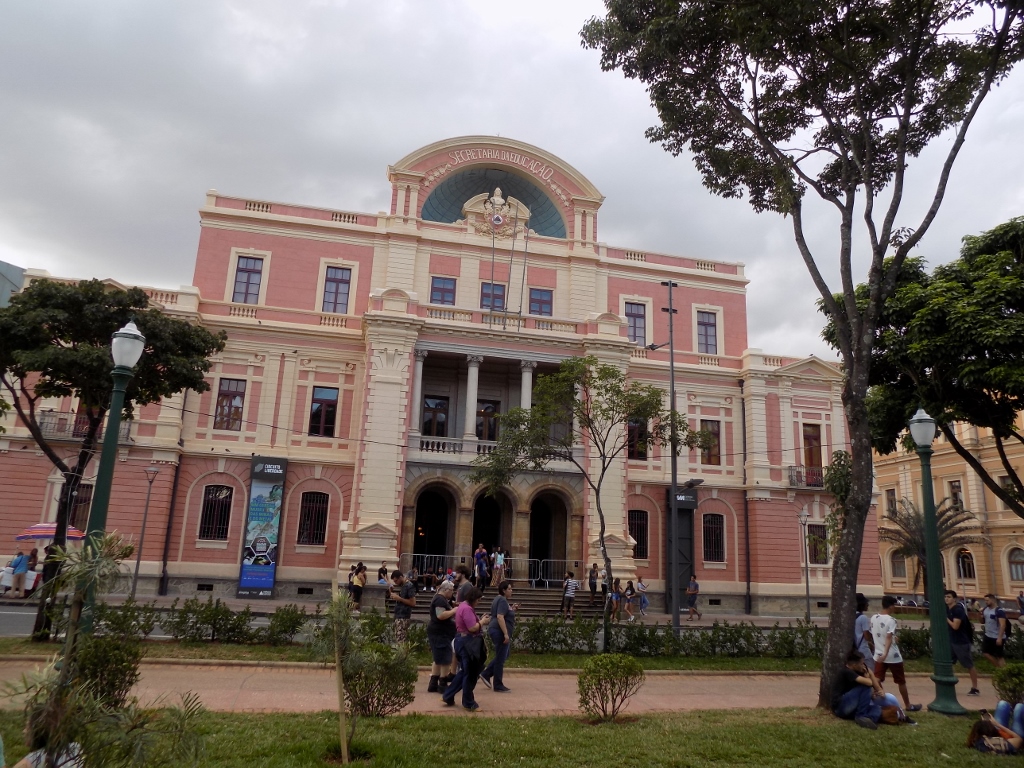 Museum of Mines and Metals
Museum of Mines and Metals
Then we had a little bit more time before the closing and we used the time to visit another museum right next to the first one. This other one is called the Memorial Minas Gerais Vale and it is a combination of a historical and ethnographic museum of the federal state of Minas Gerais. Within the museum there is a part dedicated to famous artists born in this federal state: one is a writer of prose, another one is a writer of poetry, and there is one painter and one photographer. I must admit that before this visit I had heard only of the photographer and not only that I had heard about him, but I had also watched a documentary dedicated to his work which I can recommend wholeheartedly. The photographer is Sebastião Salgado and the fantastic documentary about him is called “The Salt of the Earth.”
With this second museum we finished with the sightseeing for the day, so we first walked leisurely around the rectangular Liberty Square (Praça da Liberdade) in the centre of which there is a park that was full of people. On the opposite side from the museums, there is a large building of the Bank of Brazil Cultural Centre, which itself contains and offers numerous cultural events and there are also cafés inside of it.
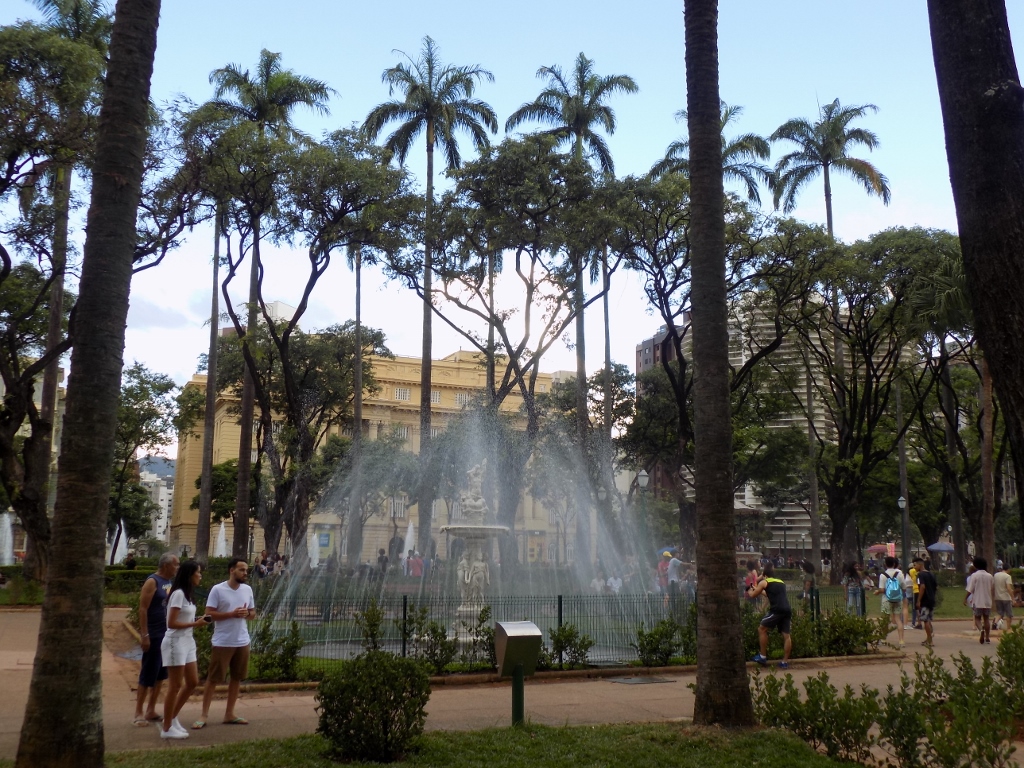 Fountain and park at Praça da Liberdade, with the Bank of Brazil Cultural Centre in the background
Fountain and park at Praça da Liberdade, with the Bank of Brazil Cultural Centre in the background
However, by this time, we were rather hungry and we wanted to eat closer to our hotel so we headed in its direction and soon came across a nice restaurant. There we opted for one of the Brazilian specialties, feijoada, basically a stew made of black beans and meat with a lot of additions on the side. Here is the photo:
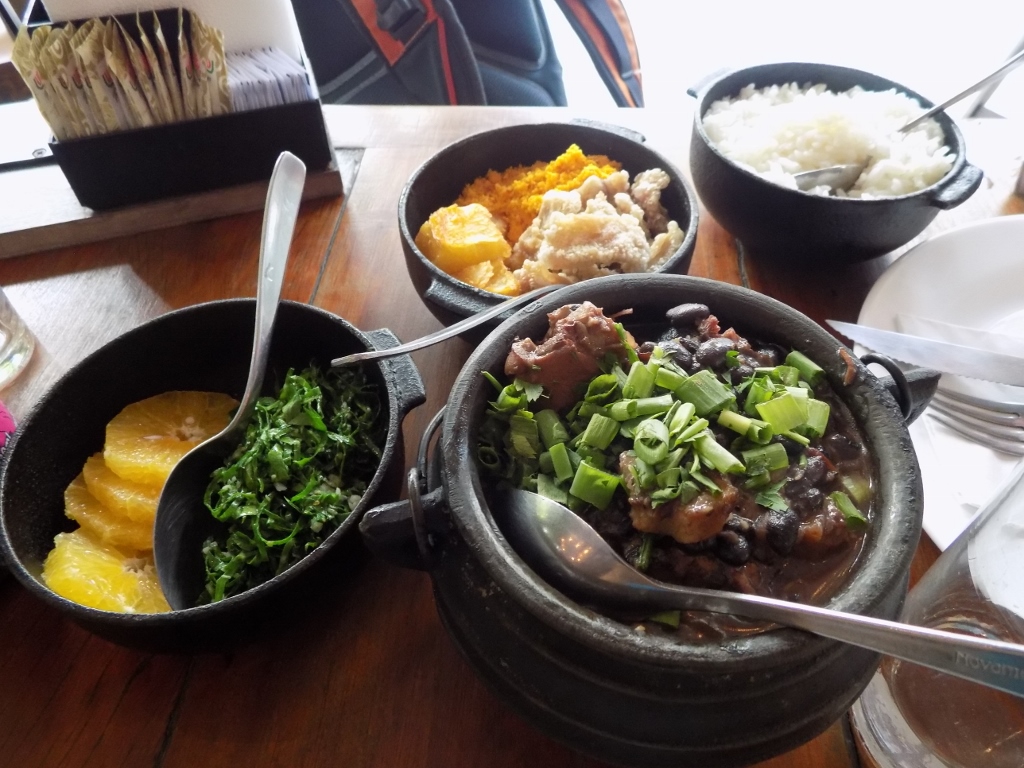 Feijoada
Feijoada
Taking into consideration the heat I was exposed to the entire day, even before the meal arrived I had a need to refresh myself properly, so I ordered a beer, local one – Belorizontina – and all of its 600 ml.
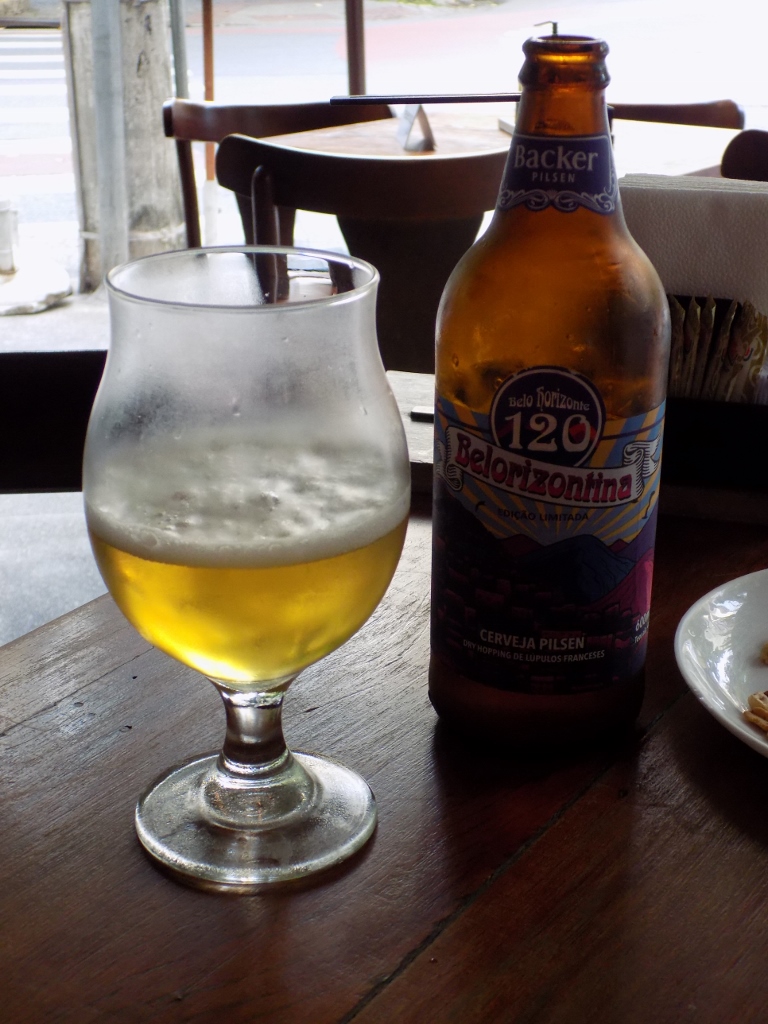 Local beer in Belo Horizonte
Local beer in Belo Horizonte
After this we walked back to the hotel, got our things from there and went to the coach terminal since there was a night-ride ahead of us that was to take us to Brasilia, the capital.
Brazil is a huge country, by its surface area it is the fifth largest in the world (by the way, it is also the fifth largest in the world by the number of residents – over 210 million). This means that from time to time coaches take unbelievably long in order to get from one place to another. For this reason, we had decided to spend this night travelling, thus killing two birds with one stone.
This experience was great, mostly because never before had I slept so well in any public transportation. The journey took 11 hours and I bet I slept at least 10. Moreover, when we somehow managed to wake up in the morning, with our squinting eyes Sneža and I looked out of the window wondering where we were, since the coach was parked at a terminal, and whether we should get out to stretch our legs. Then we started to realise that actually everybody else was leaving the coach and it was only the two of us that were puzzled and that sleepily looked around ourselves without a clue. And then our brains finally switched on and soon we were out, too, at the inter-city coach terminal in Brasilia. By the way, here it is called the Interstate Coach Terminal (Rodoviária Interestadual) since Brasilia is located within the smallest federal state that is suitably called the Federal District.
Since we arrived at the hotel rather early, we had to wait for a couple of hours until our room was ready. We used this time first to have an excellent breakfast that was going on at the time when we arrived. Then we walked to a tourist info centre that was supposed to be a 100 m away from our hotel according to the map, but actually there was nothing of the sort there. Still, this walk around the hotel was good in order for us to start to understand better the position of our hotel with respect to the city and its main landmarks.
When we finally got the room we decided to have some rest after all, because no matter how much the sleeping on the coach seemed or was long, it was certainly not the most ideal. Afterwards, at some point we decided to go for a walk in order to see something, as well as to get a concrete idea about the distribution of the city and the buildings in it.
Brasilia is a very unusual city. Made out of nothing. Historically, since 1891, there had been an idea to move the capital from Rio to some other place more centrally located. It was only in 1956 when Juscelino Kubitschek became the President of the country that he instigated the entire project, in 1957 the design by urban planner Lucio Costa was selected and within incredible 41 months the city was inaugurated.
The urban planner Lucio Costa designed the city in such a way that it extends along two transverse axes, with one of them being slightly curved. What is obtained by this concept, when having a bird’s eye view, is often described as a cross, an airplane, a dragonfly or a bird. I’m personally mostly reminded of the Condor from Nazca in Peru (this is one of those geoglyphs that constitute the famous Nazca Lines).
Be as it may, the central line that is straight and that is called the Monumental Axis (Eixo Monumental) goes approximately along the east-west direction. Along its centre there is a green area that is occasionally cut through by traffic roads, while the entire green section is surrounded by a broad avenue. Sneža and I visited only the part that would constitute the “body and head” of the imaginary bird, condor or whatever, and that was more than enough since this section alone is around 4 km long.
To start with, I went to the top of our hotel in order to get a better view at the surroundings. We were quite close to the TV tower that is one of the landmarks of the city.
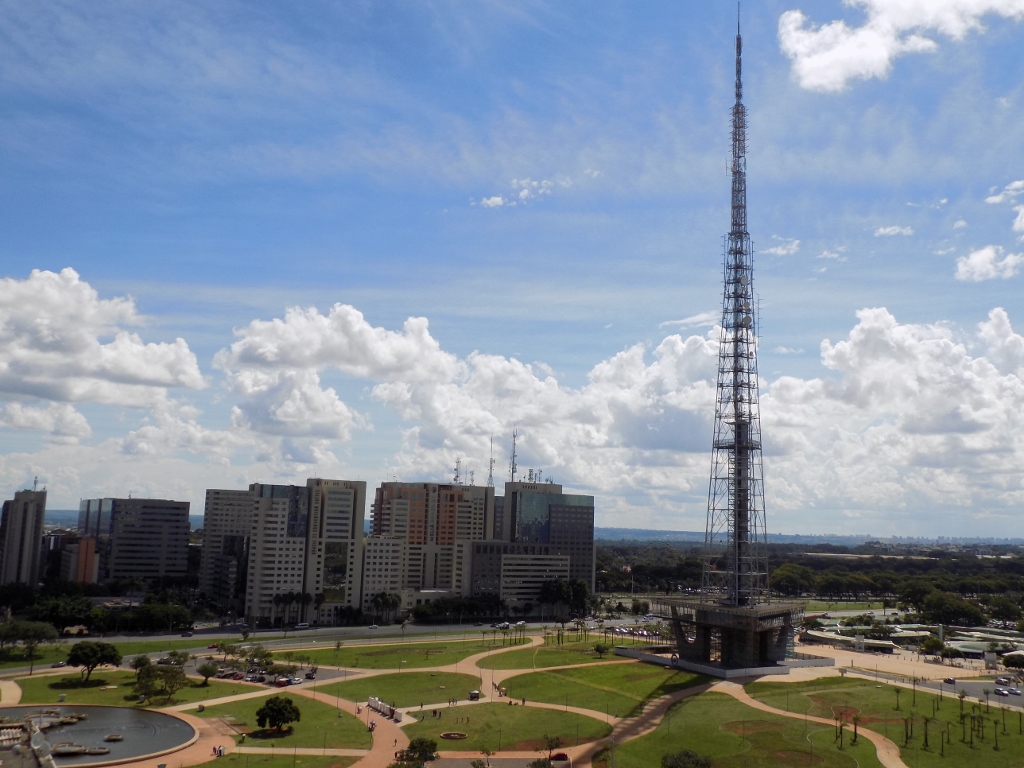 TV tower and the green section of the Monumental Axis; the buildings belong to the South Hotel Sector
TV tower and the green section of the Monumental Axis; the buildings belong to the South Hotel Sector
From the TV tower down the Monumental Axis there is mild sloping of the terrain towards the central square of Brasilia called Three Powers Plaza (Praça dos Três Poderes). Along the avenue that leads around the central green area, there are sectors with hotels, commercial buildings and banks, then there is a slightly specific part that includes some cultural institutions, which we visited on the first day, then a part called the Esplanade of Ministries and finally at the end of the green area there is the National Congress, on the other side of which is Three Powers Plaza. As the name suggests, all of this was made – monumentally. The avenue that goes around this extended rectangle has 6 lanes that all go in the single direction only since, as I’ve said, the street goes around the green area.
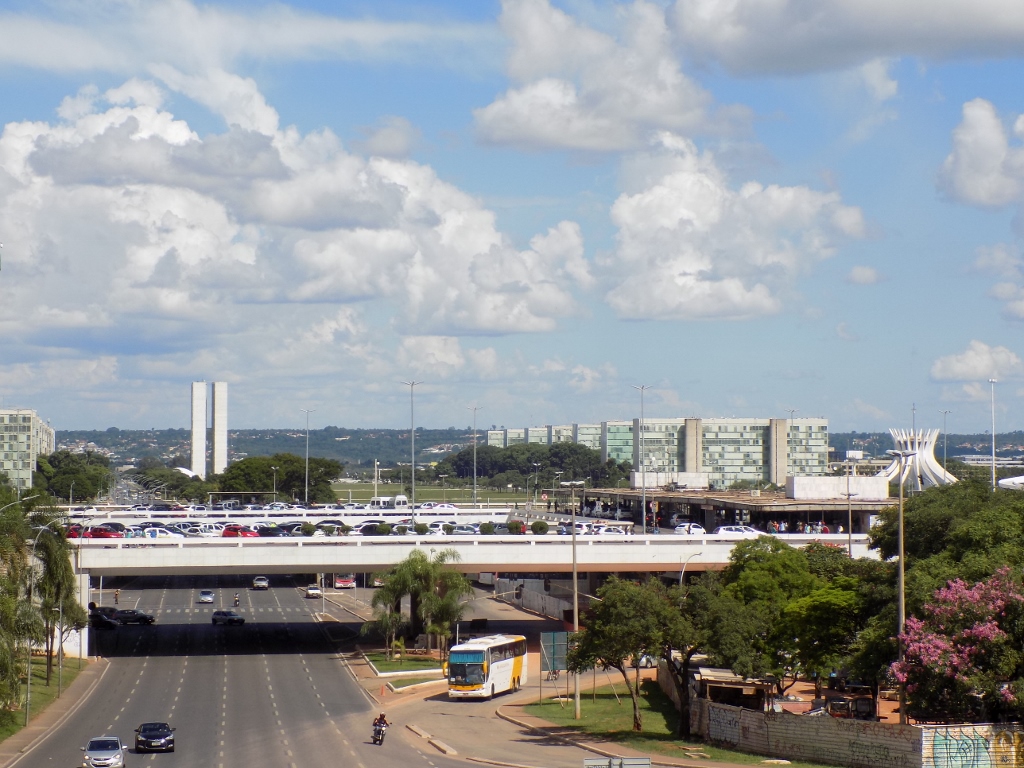 View down the Monumental Axis: two white high-rises are a part of the National Congress, while some ministries and the cathedral may be seen on the left-hand side
View down the Monumental Axis: two white high-rises are a part of the National Congress, while some ministries and the cathedral may be seen on the left-hand side
This green area that I keep mentioning is primarily an open space with few trees and I guess this entire area additionally accentuates the monumentality of it all.
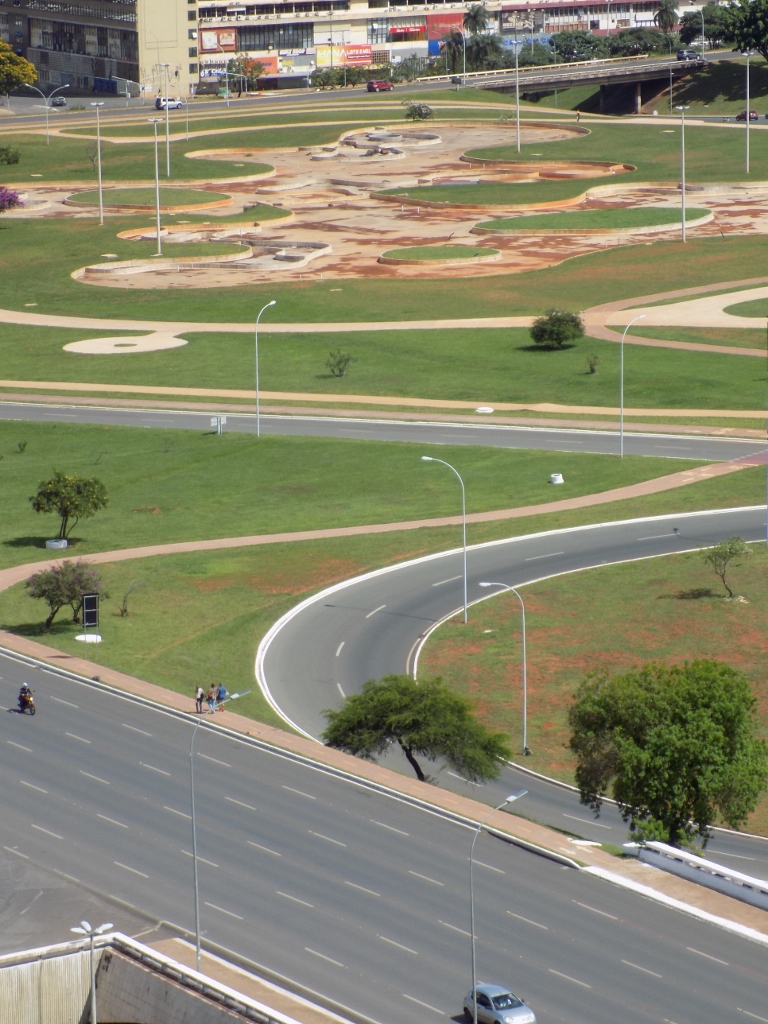 A detail of the Monumental axis: the main avenue, streets leading to the transverse streets and the green area
A detail of the Monumental axis: the main avenue, streets leading to the transverse streets and the green area
The mildly curved axis I have mentioned above constitutes the “wings” of the imaginary bird or airplane and along that direction there are blocks of residential buildings with everything they may need locally. The width of those “wings” goes from the TV tower to the Esplanade of Ministries. And that would be the main ground plan of the city.
We started from the North Hotel Sector and decided to walk along the green area. But, first we had to cross to the other side of the street. With a lot of waiting for the pedestrian green light to be turned on, we finally walked to the other side of the avenue and headed down the very mild slope.
It was early in the afternoon, it was hot and very humid. And practically no trees and shade to speak of. We wondered why there was no park with a lot of trees there and Sneža started immediately to say that this was not a city fit for living. I somehow decided to wait a little before coming to any conclusion of mine.
Needless to say, Sneža is not alone in her opinion. There are many people who criticise Brasilia precisely because of the occasional lack of humane aspect, but I must admit that to this very day I personally have remained indecisive. Certain buildings are impressive indeed, but on the other hand I know that I did not enjoy walking for half an hour or an hour in the hot tropical Sun with no shade. Still... First, the authors – urban planner Lucio Costa, architect Oscar Niemeyer and landscape architect Roberto Burle Marx, they all belonged to the modern age and perhaps they thought that in the near future everybody would have their private flying saucers with air-conditioners, so they would not need any shade at all. Second, the authors obviously had carte blanche and could let their imagination run wild and this imagination of theirs had very modern inclinations. To expect classic lines and shade here would be the same as expecting Picasso to put all the eyes, ears and other parts of the body in their traditional places. In other words, Brasilia should be looked at as a piece of art and not as a practical city for pedestrians and tourists.
But, as a proper pedestrian tourist, I occasionally stopped in order to take photos, trying to ignore the heat and the feeling of unpleasantness it was creating in me.
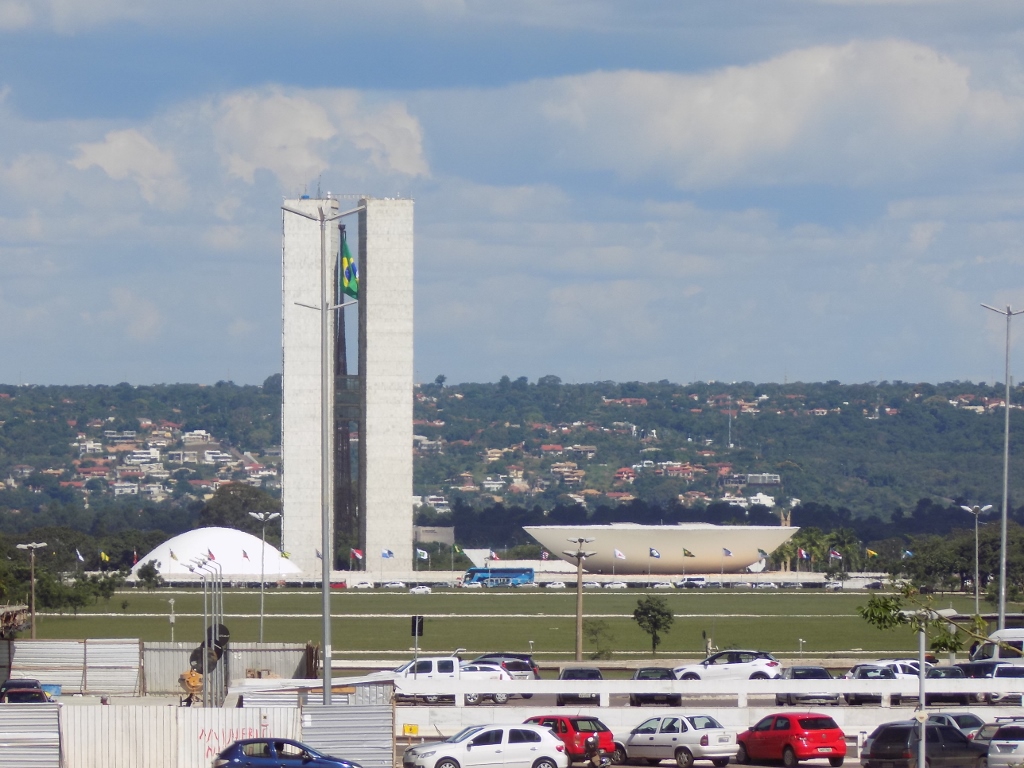 National Congress building
National Congress building
Thus we came to a spacious plateau where there is the National Library, as well as the National Museum.
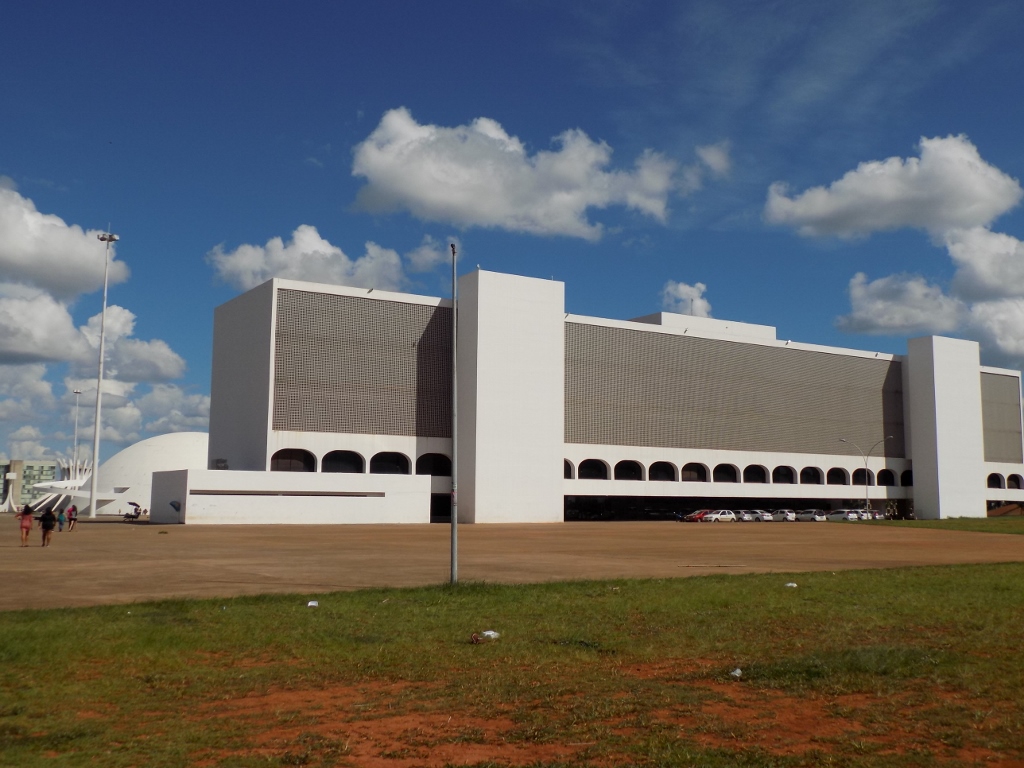 National Library; the National Museum may be discerned behind it
National Library; the National Museum may be discerned behind it
Sneža still did not like the concept with so much concrete and paved space without a speck of greenery and consequently with no shade. I agree, it seemed rather desert-like – hot and empty, but under a wave of inspiration linked to the interpreting of other people’s intentions I said that we actually had no idea what the architects really wanted to achieve with this. Perhaps this was all intentional, as an invitation to visit the library or the museum under a slogan “don’t stay out in the hot Sun; come into these spaces where you will find much more than a mere shade.”
Although I would personally still try to make sure there were a lot of trees in this central area and on the plateau, I must admit that even on this first day Brasilia started to win me over. Not right away, but with each new impression and with each new day spent here I liked it more and more, and I increasingly enjoyed its futuristic concept.
For instance, the National Museum in Brasilia...
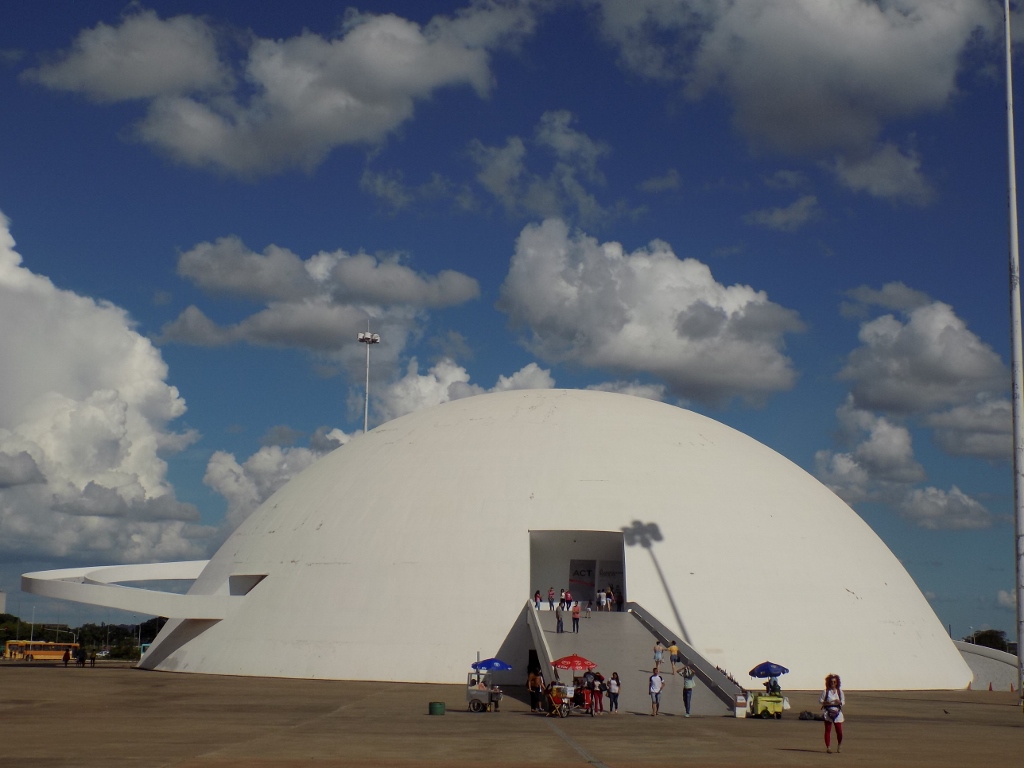 National Museum, access ramp used for entering the museum
National Museum, access ramp used for entering the museum
Both the National Library and the National Museum were designed by the famous Brazilian architect Oscar Niemeyer. However, one should not expect a huge “real” national museum that holds the most important exhibits of the nation. No, this one concretely (no pun intended) is used actually for temporary exhibitions, but already by itself it is a piece of art.
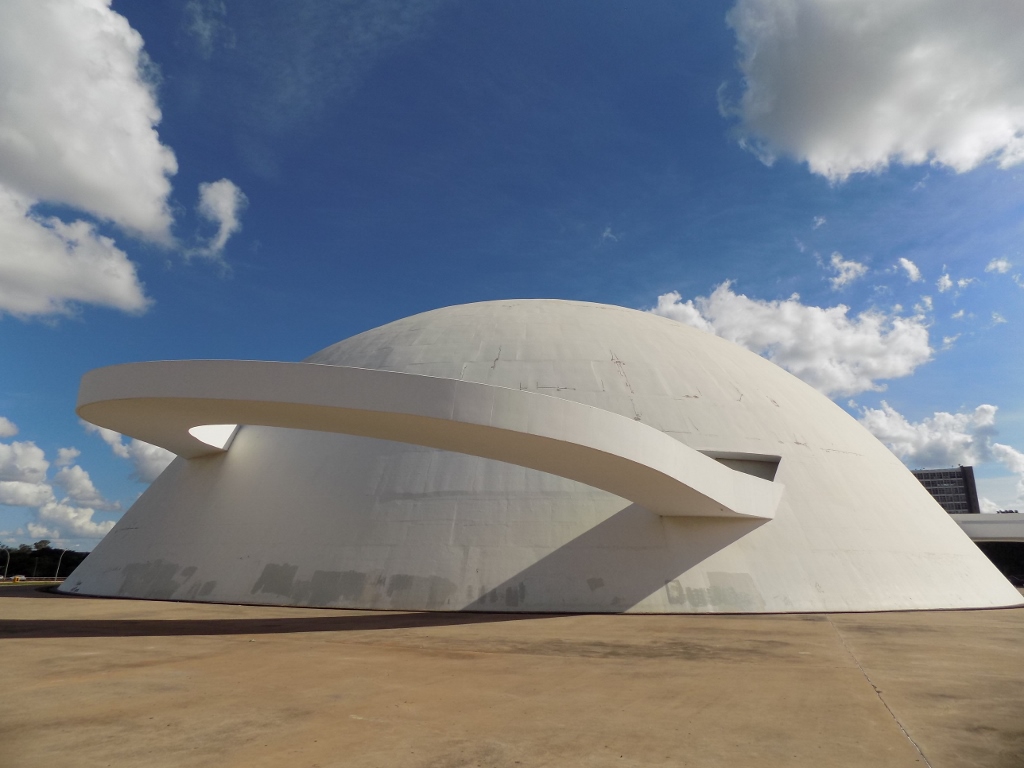 National Museum, exterior ramp
National Museum, exterior ramp
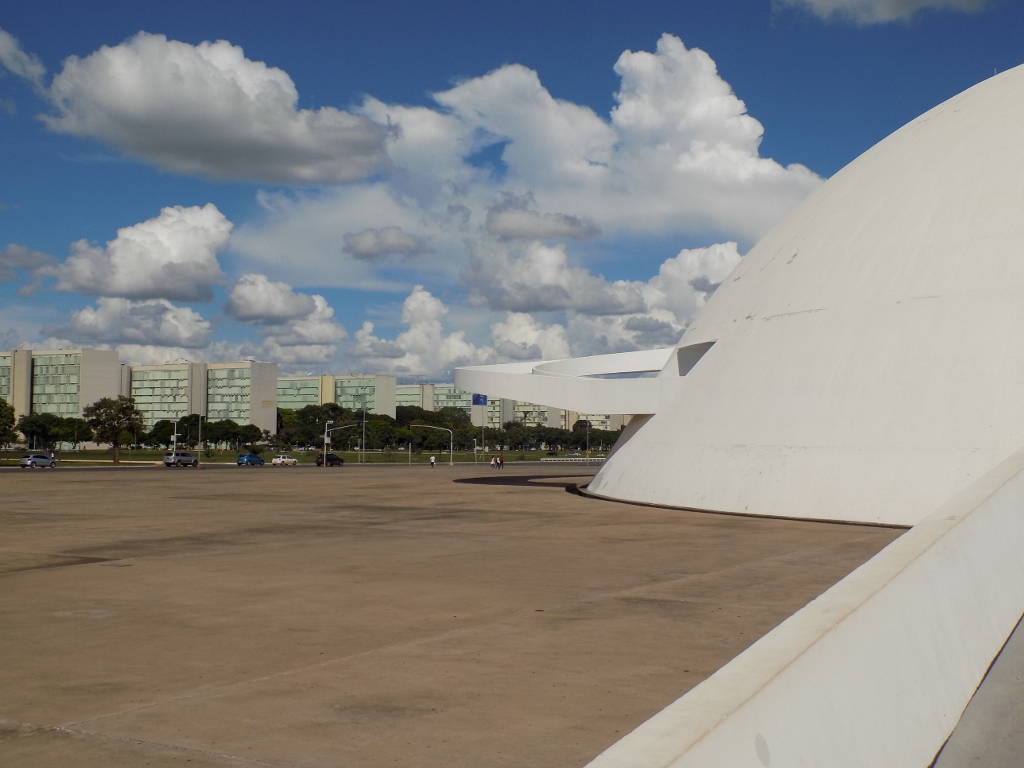 National Museum, view from the access ramp towards the Esplanade of Ministries
National Museum, view from the access ramp towards the Esplanade of Ministries
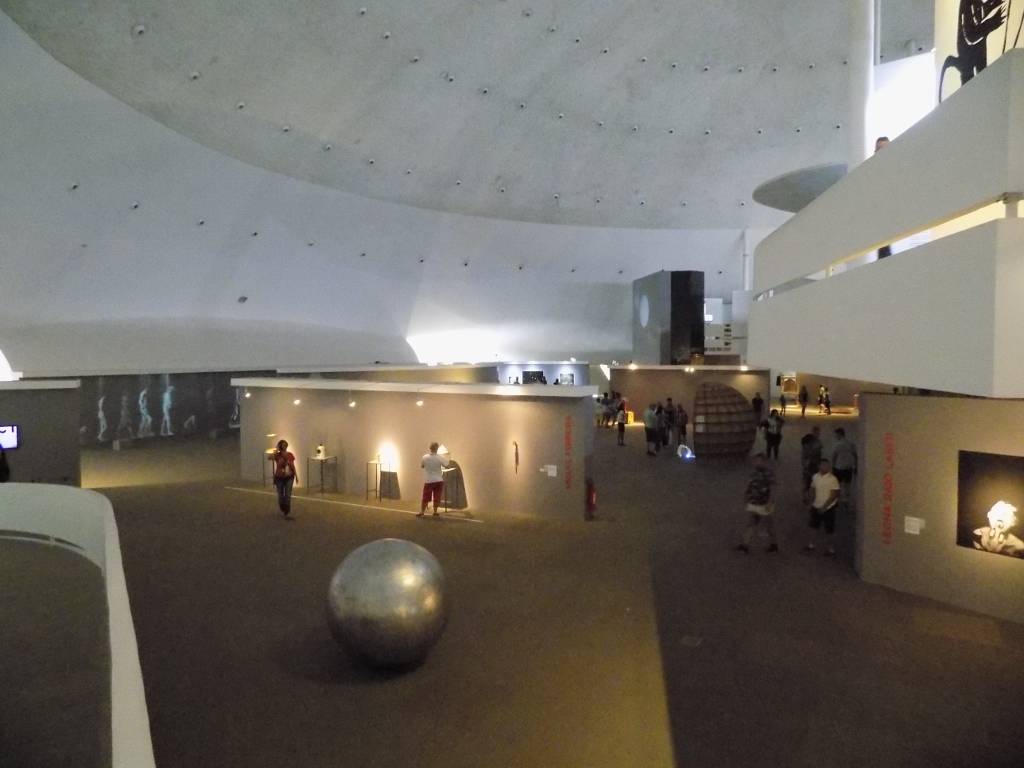 National Museum, the interior
National Museum, the interior
We entered the National Museum for a short while. Partially to see it from the inside, partially to see a contemporary exhibition and partially in order to move away from the scorching Sun. As it can be seen on the next photo, we were not the only one yearning for shade.
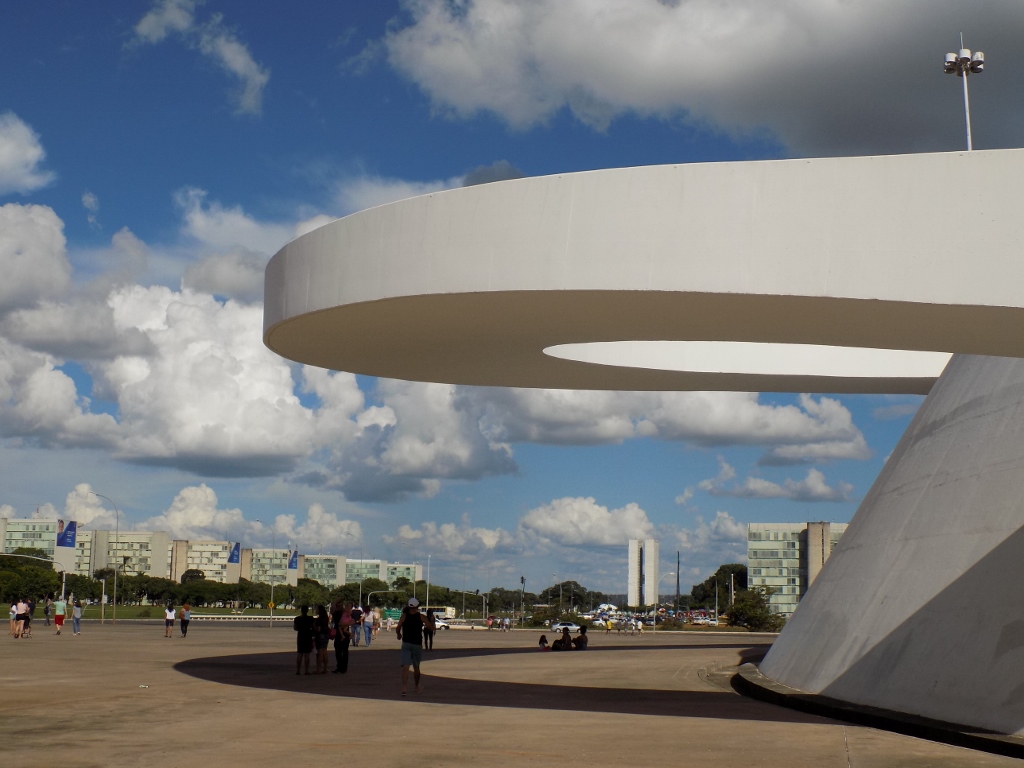 National Museum, a detail, and the view towards the National Congress
National Museum, a detail, and the view towards the National Congress